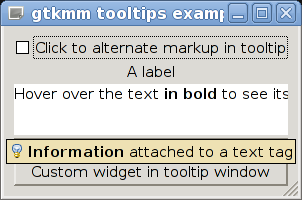Tooltips
Tooltips are the little information windows that pop up when you leave your pointer over a widget for a few seconds. Use set_tooltip_text() to set a text string as a tooltip on any Widget. Gtk::Tooltip is used for more advanced tooltip usage, such as showing an image as well as text.
- 8.6.1. Example
8.6.1. Example
File: examplewindow.h (For use with gtkmm 4)
#ifndef GTKMM_EXAMPLEWINDOW_H
#define GTKMM_EXAMPLEWINDOW_H
#include <gtkmm.h>
class ExampleWindow : public Gtk::Window
{
public:
ExampleWindow();
virtual ~ExampleWindow();
protected:
//Methods:
void prepare_textview();
void connect_signals();
//Signal handlers:
void on_markup_checkbutton_toggled();
bool on_textview_query_tooltip(int x, int y, bool keyboard_tooltip, const Glib::RefPtr<Gtk::Tooltip>& tooltip);
bool on_button_query_tooltip(int x, int y, bool keyboard_tooltip, const Glib::RefPtr<Gtk::Tooltip>& tooltip);
//Child widgets:
Gtk::Box m_vbox;
Gtk::CheckButton m_checkbutton;
Gtk::Label m_label;
Gtk::ScrolledWindow m_scrolled_window;
Gtk::TextView m_text_view;
Glib::RefPtr<Gtk::TextBuffer> m_ref_text_buffer;
Glib::RefPtr<Gtk::TextTag> m_ref_bold_tag;
Gtk::Button m_button;
Gtk::Box m_button_tooltip_widget;
};
#endif // GTKMM_EXAMPLEWINDOW_H
File: main.cc (For use with gtkmm 4)
#include "examplewindow.h"
#include <gtkmm/application.h>
int main(int argc, char *argv[])
{
auto app = Gtk::Application::create("org.gtkmm.example");
//Shows the window and returns when it is closed.
return app->make_window_and_run<ExampleWindow>(argc, argv);
}
File: examplewindow.cc (For use with gtkmm 4)
#include "examplewindow.h"
#include <vector>
const Glib::ustring app_title = "gtkmm tooltips example";
const Glib::ustring non_markedup_tip = "A tooltip without markup.";
const Glib::ustring markedup_tip = "<i>Markup</i> in a tooltip.";
ExampleWindow::ExampleWindow()
:
m_vbox(Gtk::Orientation::VERTICAL, 3),
m_checkbutton("Click to alternate markup in tooltip"),
m_label("A label"),
m_button("Button with a custom tooltip widget")
{
//Set up window and the top-level container:
set_title(app_title);
m_vbox.set_margin(10);
set_child(m_vbox);
//Check button with markup in tooltip:
m_checkbutton.set_tooltip_text(non_markedup_tip);
m_vbox.append(m_checkbutton);
//Label:
m_label.set_tooltip_text("Another tooltip");
m_vbox.append(m_label);
//Textview:
prepare_textview();
//Button:
//When only connecting to the query-tooltip signal, and not using any
//of set_tooltip_text() or set_tooltip_markup(), we need to explicitly
//tell GTK that the widget has a tooltip which we'll show.
m_button.set_has_tooltip();
m_vbox.append(m_button);
//Button's custom tooltip widget:
auto label = Gtk::make_managed<Gtk::Label>("A label in a custom tooltip widget");
m_button_tooltip_widget.append(*label);
connect_signals();
}
ExampleWindow::~ExampleWindow()
{
}
void ExampleWindow::prepare_textview()
{
Gtk::TextIter iter;
std::vector<Glib::RefPtr<Gtk::TextTag>> tags;
//Set up a scrolled window:
m_scrolled_window.set_child(m_text_view);
m_scrolled_window.set_policy(Gtk::PolicyType::AUTOMATIC, Gtk::PolicyType::AUTOMATIC);
m_scrolled_window.set_expand();
m_vbox.append(m_scrolled_window);
//Create a text buffer with some text:
m_ref_text_buffer = Gtk::TextBuffer::create();
iter = m_ref_text_buffer->end();
m_ref_text_buffer->insert(iter, "Hover over the text ");
//Insert some text with a tag.
//In the tooltip signal handler below, we will show a tooltip
//when mouse pointer is above this tagged text.
m_ref_bold_tag = m_ref_text_buffer->create_tag("bold");
m_ref_bold_tag->set_property("weight", Pango::Weight::BOLD);
tags.push_back(m_ref_bold_tag);
iter = m_ref_text_buffer->end();
m_ref_text_buffer->insert_with_tags(iter, "in bold", tags);
iter = m_ref_text_buffer->end();
m_ref_text_buffer->insert(iter, " to see its tooltip");
m_text_view.set_buffer(m_ref_text_buffer);
m_text_view.set_size_request(320, 50);
//When only connecting to the query-tooltip signal, and not using any
//of set_tooltip_text() or set_tooltip_markup(), we need to explicitly
//tell GTK that the widget has a tooltip which we'll show.
m_text_view.set_has_tooltip();
}
void ExampleWindow::connect_signals()
{
m_checkbutton.signal_toggled().connect(
sigc::mem_fun(*this, &ExampleWindow::on_markup_checkbutton_toggled));
m_text_view.signal_query_tooltip().connect(
sigc::mem_fun(*this, &ExampleWindow::on_textview_query_tooltip), true);
m_button.signal_query_tooltip().connect(
sigc::mem_fun(*this, &ExampleWindow::on_button_query_tooltip), true);
}
void ExampleWindow::on_markup_checkbutton_toggled()
{
if (m_checkbutton.get_active())
{
m_checkbutton.set_tooltip_markup(markedup_tip);
}
else
{
m_checkbutton.set_tooltip_markup(non_markedup_tip);
}
}
bool ExampleWindow::on_textview_query_tooltip(int x, int y, bool keyboard_tooltip, const Glib::RefPtr<Gtk::Tooltip>& tooltip)
{
Gtk::TextIter iter;
if (keyboard_tooltip)
{
int offset = m_ref_text_buffer->property_cursor_position().get_value();
iter = m_ref_text_buffer->get_iter_at_offset(offset);
}
else
{
int mouse_x, mouse_y, trailing;
m_text_view.window_to_buffer_coords(Gtk::TextWindowType::TEXT,
x, y, mouse_x, mouse_y);
m_text_view.get_iter_at_position(iter, trailing, mouse_x, mouse_y);
}
if (!iter.has_tag(m_ref_bold_tag))
return false;
//Show a tooltip if the cursor or mouse pointer is over the text
//with the specific tag:
tooltip->set_markup("<b>Information</b> attached to a text tag");
tooltip->set_icon("dialog-information");
return true;
}
bool ExampleWindow::on_button_query_tooltip(int, int, bool, const Glib::RefPtr<Gtk::Tooltip>& tooltip)
{
tooltip->set_custom(m_button_tooltip_widget);
return true;
}

